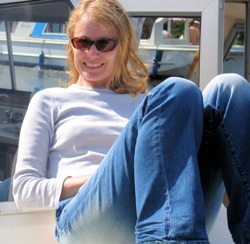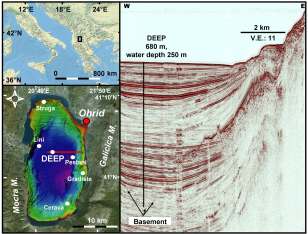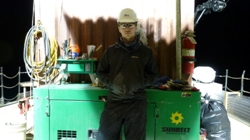 The deep drilling of Lake Ohrid in the Balkan, by Professor Melanie Leng*
The deep drilling of Lake Ohrid in the Balkan, by Professor Melanie Leng*
In 2012 the UK became a member of the International Continental Scientific Drilling Program (ICDP). Membership was sponsored by the British Geological Survey for the Earth science community to enable the proposal of- and participation in- International research projects involving deep drilling. The community soon mobilised and several UK geoscientists are now involved in ICDP research.
Of paticular interest to me is the project called Scientific Collaboration on Past Speciation Conditions in Lake Ohrid (SCOPSCO) with it’s four major aims: (i) To obtain more precise information about the age and origin of the lake, (ii) to unravel the seismotectonic history of the lake area including effects of major earthquakes and associated mass wasting events, (iii) to obtain a continuous record containing information on volcanic activities and climate change in the central northern Mediterranean region, and (iv) to better understand the impact of major geological/environmental events on general evolutionary patterns and shaping an extraordinary degree of endemic biodiversity. The SCOPSCO project had been in the ICDP pipeline for several years, and it was lucky for me that the funding was all finally agreed (from a complicated mix of sources) in late 2012 soon after the UK became an ICDP member. I was subsequently invited to be the UK’s principal investigator on SCOPSCO looking after the isotope component of the project.
Some information on Lake Ohrid

Picture: Lake Ohrid in Macedonia
Lake Ohrid was declared UNESCO World Heritage Site in 1979. The lake is about 30 km long, 15 km wide, covers an area of 358 km2, and is located at an altitude of 693 m a.s.l. between the Republics of Albania and Macedonia. The lake has a maximum water depth of 289 m and a volume of 55.4 km3. The most intriguing characteristic of Lake Ohrid is its extraordinary high degree of endemism, comprising 212 described endemic species. Lake Ohrid is also considered to be the oldest continuously existing lake in Europe. However, age estimations are not precise. Geological studies show that the lake basin formed during the latest phases of Alpine orogeny in a graben and that the lake is probably 2 to 5 Ma old. Molecular “clock” analyses of several endemic species flocks (i.e., groups of closely related species) indicate that Lake Ohrid is probably 1.5 to 3 Ma old (Trajanovski et al., 2010). Despite the uncertainties in the age estimations, the proposed continuous existence makes Lake Ohrid an extant hot spot of evolution and/or a potential evolutionary reservoir enabling the survival of relict species (Albrecht and Wilke, 2008).
Diagram: Lake Ohrid on the Balkan Peninsula (left). ICDP coring sites are indicated by white dots. The red line in crossing the DEEP site in the centre of the lake indicates the location of the seismic profile (right).
 Moreover, Ohrid is amongst the world's oldest lakes. Extant sedimentary records from Lake Ohrid cover, including some hiatuses, the past glacial/interglacial cycle and reveal that Lake Ohrid is a valuable archive of climate change in the central northern Mediterranean region (e.g. Wagner and Wilke, 2011). Moreover, Lake Ohrid is an important distal archive for the activity of Italian volcanoes, as it is located downwind of the prominent volcanic regions in Italy. Tephras also provide information on ash dispersal and can be used for chronological constraints on the records themselves, but also for other records in the region by cross correlation of their geochemical fingerprints. Finally, Lake Ohrid sediments provide useful information on tectonic events. Because Lake Ohrid is located in a highly active seismic zone with frequent earthquakes, the lake sediments on the subaquatic slopes are likely subject to mass wasting and seismite formation.
Moreover, Ohrid is amongst the world's oldest lakes. Extant sedimentary records from Lake Ohrid cover, including some hiatuses, the past glacial/interglacial cycle and reveal that Lake Ohrid is a valuable archive of climate change in the central northern Mediterranean region (e.g. Wagner and Wilke, 2011). Moreover, Lake Ohrid is an important distal archive for the activity of Italian volcanoes, as it is located downwind of the prominent volcanic regions in Italy. Tephras also provide information on ash dispersal and can be used for chronological constraints on the records themselves, but also for other records in the region by cross correlation of their geochemical fingerprints. Finally, Lake Ohrid sediments provide useful information on tectonic events. Because Lake Ohrid is located in a highly active seismic zone with frequent earthquakes, the lake sediments on the subaquatic slopes are likely subject to mass wasting and seismite formation.
The cores and some initial results
In April/May 2013 the deep lake drilling of Ohrid was undertaken. Four sites were targeted in water depths ranging from 80 to 260 m and drilling target depths from 20 to 680 m. A total of 2100m of sediment were recovered from Lake Ohrid and it was heralded as one of the most successful ICDP lake drilling campaigns ever. At the “DEEP” site in the center of the lake, the hydro-acoustic data implied a maximum sediment fill of ca. 700 m, of which the uppermost 568 m sediment were recovered. Coarse-grained gravel and pebbles underlying clay and shallow water facies hampered deeper penetration. Six boreholes at the “DEEP” site resulted in a total of 1526 m of sediment cores and a composite field recovery of 544 m (95%). Three additional sites at more lateral parts of Lake Ohrid were drilled to unravel lake level fluctuations, catchment dynamics, biodiversity and evolution processes (“Cerava”, drilled to 90 m), active tectonics and spring dynamics (“Gradiste”, drilled to 123 m), and the early development of the Ohrid Basin (“Pestani”, drilled to 194 m). The cores are now stored at the University of Cologne, Germany, where core opening, core description and documentation, and first analyses such as Multi-Sensor Core Logging (MSCL) and X-ray fluorescence (XRF) scanning is currently taking place.
 Image: PhD student Jack Lacey on board the drilling platform
Image: PhD student Jack Lacey on board the drilling platform
Initial borehole logging data, and geochemical and susceptibility data from the cores imply that the sediments from the “DEEP” site are highly sensitive to climate and environmental change and likely span >1.2 million years. Particularly the carbonate content in the sediments is a significant proxy for temperature change, as carbonate precipitation and preservation is closely related to warm temperatures and takes place mainly during the interglacials, whilst the glacial periods contain no or only low amounts of carbonate. The data available show several cycles of carbonate precipitation in the top ca. 280 m, which can be linked to the 100 ka cyclicity, and a higher frequency between ca. 280 m and at the core base, which is likely correlated with the 40 ka cycles. These initial results and those of previous calibration data sets indicate that Lake Ohrid provides an extraordinary record of environmental change in the northern Mediterranean and will become a key site for a better understanding of speciation triggers. I look forward (with my collaborators in the UK and overseas) to help unravel the great mysteries from Lake Ohrid using isotope techniques (with PhD student Jack Lacey from Leicester University) and diatom ecology (with Dr Jane Reed and PhD student Xiaosen Zhang from Hull University).
Acknowledgements
Financial and logistic support for the SCOPSCO coring campaign was provided by ICDP, the German Ministry of Education and Science, the German Research Foundation, the British Geological Survey, the INGV and CNR (both Italy), and the Governments of the Republics of Macedonia (FYROM) and Albania. DOSECC operated the deep drilling very successfully.

THE SCOPSCO LEADING INVESTIGATORS: BERND WAGNER, Institute of Geology and Mineralogy, University of Cologne, Germany; THOMAS WILKE, Department of Animal Ecology & Systematics, Justus Liebig University Giessen, Germany; SEBASTIAN KRASTEL, Institute of Geosciences, Christian-Albrechts-Universität zu Kiel, Germany; GIOVANNI ZANCHETTA, Dipartimento di Scienze della Terra, University of Pisa, Italy; ROBERTO SULPIZIO, Dipartimento di Scienze della Terra e Geoambientali, University of Bari, Italy; KLAUS REICHERTER, RWTH Aachen, Germany; MELANIE LENG, British Geological Survey & Department of Geology, University of Leicester, UK; ANDON GRASHDANI, Faculty of Geology and Mineralogy, University of Tirana, Albania; SASHO TRAJANOVSKI, Hydrobiological Institute Ohrid, Macedonia; ZLATKO LEVKOV, Institute of Biology, University of Skopje, Macedonia; JANE REED, University of Hull, UK; THOMAS WONIK, LIAG Hannover, Germany
References
- Albrecht, C. and T.Wilke (2008), Lake Ohrid: biodiversity and evolution. Hydrobiologia, 615, 103140.
- Trajanovski, S., C. Albrecht, K. Schreiber, R. Schultheiß, T. Stadler, M. Benke, and T. Wilke (2010), Testing the spatial and temporal framework of speciation in an ancient lake species flock: the leech genus Dina (Hirudinea: Erpobdellidae) in Lake Ohrid. Biogeosciences, 7, 3387-3402.
- Wagner, B. and T. Wilke (2011), Evolutionary history of the Balkan lakes Ohrid and Prespa, Biogeosciences, 8, 995-998.